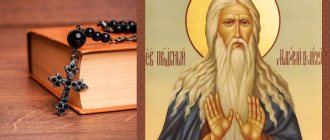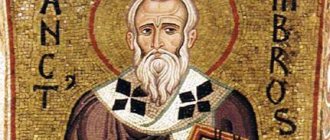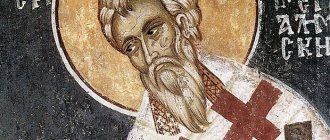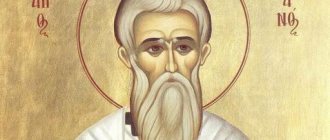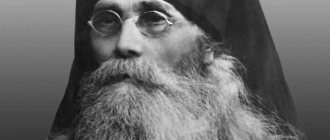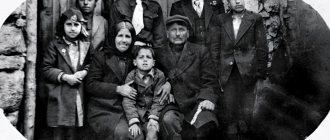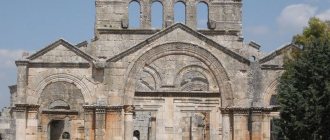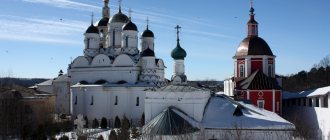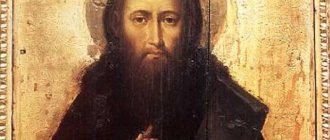The canon and dogmas of the Orthodox Church were formed within 2000 years after the death of Jesus Christ. Clergy, monks, bishops and theologians made their contribution. One of the most important figures in the Church is St. Nicodemus the Holy Mountain, whose spiritual works and interpretations of a theoretical, mystical, dogmatic and apologetic nature seriously influenced the teaching of the Church.
He was the author of more than 200 literary works and chants, and after his death he became one of the canonized saints of the Russian Orthodox Church.
Life of Saint Nicodemus the Holy Mountain
From childhood until his death, the worldly path of Saint Nicodemus was devoted to the comprehension of sciences, religious works, the study of prayer and spiritual development. Being an educated, comprehensively developed and talented servant of the Lord, he humbly learned obedience and schema. The monk interrupted his monastic exploits only for the sake of literary creativity, in which he reached high heights.
Passage and education
The future saint was born in 1749 into a pious Greek family of Christians devoted to God, Anthony and Kalyvoursi Kalyvourciss. The parents named the baby Nikolai. The boy grew up in a religious environment, receiving his first Christian knowledge from his mother and father. Nicholas's mother later became a monk, and his cousin became a bishop.
The boy grew up virtuous, truly believing in the Lord God and striving to imitate the saints, from childhood he zealously defended justice. In the elementary grades of school, Nikolai was distinguished by his lively mind, good memory and diligence, surpassing his peers in studying subjects.
The teacher-priest who taught at the school appreciated the student’s efforts and virtue. He took him to worship services as an assistant. Nikolai willingly visited the temple, becoming more and more imbued with love for the Lord.
Having received his primary education, the boy continued his studies in languages and sciences at a school on the island of Smyrna. The young man greedily absorbed knowledge, mastered 4 languages and enthusiastically listened to his teachers’ stories about monastic life. He willingly helped others and served in the local church, and was known for his meekness and kindness.
Having successfully completed his school course, Nikolai returned to his native island of Naxos. The young man’s education and recommendations from teachers helped him get the position of secretary of the metropolitan, where he worked for the next 5 years. At this time, thoughts about monasticism began to visit him. The desire to take monastic vows only grew stronger every year.
At the age of 25, the young man decides to go to a meeting with the Metropolitan of Corinth, Saint Macarius Nataras. There he met Elder Sylvester. After conversations with Nicholas, Macarius invited him, as a scientist and righteous person, to participate in the work on the publication of religious works dedicated to the Holy Fatherland.
The meeting with the elders made a special impression on the young man. He left the service and, firmly strengthened in the desire to devote himself to serving God, went to Athos.
Holy Mount Athos
Having set off, Nikolai arrived at the pier. There was no place for him on the departing ship, but this did not stop his warm heart, filled with true desire. The young man threw himself into the water and swam after the ship. The sailors took him on board.
Upon arrival on Athos, Nicholas, having secured the recommendation of Elder Sylvester, went to the monastery of Dionysiatus. In the monastery, he soon took monastic vows and was named Nicodemus.
The monk studied with interest the rules of obedience and prayer, and was a reader and scribe. Within the walls of the monastery, Nikodim began work on literary religious works. Having completed the compilation of the famous edition of the Philokalia, the collection Evergetin and the book On Constant Divine Communion, he moved to the Pantocrator monastery.
At the monastery, Elder Arsenios Peloponnesus became his spiritual mentor. Nicodemus studied the books of Holy Scripture, learned to resist temptation and passions, and developed spiritually.
Nicodemus and his spiritual father retired to a lonely cell, but even there they were found by visitors. Then they moved to the uninhabited island of Skiropula. It was not easy to survive in a waterless area, and Arseny left the shelter. Finding himself alone with God, Nicodemus created a unique book, The Exhortatory Manual. Relying only on his own knowledge, the 32-year-old monk wrote one of his best works.
At the age of 34, Nicodemus asceticised in the schema and took a vow of silence, immersed in prayer. The monastic feat was interrupted by the visit of Elder Macarius with the assignment of editing the works of Simeon the Theologian. Nicodemus began literary works.
Demise
At the age of 57, Nicodemus became powerless. In recent days, he could not write books on his own and asked the brethren for help. The monk spent his last night in prayer and received holy communion. Nicodemus' worldly journey ended on July 14, 1809 at sunrise.
early life
In the world, Nikolai Kallivurzi, was born on the Greek island of Naxos, in a family of well-behaved Christians, Anthony and Kallivurzi, in 1749.
Thanks to responsible upbringing on the part of his parents and at the call of his own heart, Nikolai was particularly religious from childhood and strove to imitate God’s saints.
He received his primary education on the territory of his small homeland, in Naxos. He owed much of his education to the local parish priest.
When Nikolai matured and reached the age of fifteen, his father sent him for further education to the Smyrna Evangelical School.
Thanks to his innate abilities, consciousness, and determination, Nikolai achieved extraordinary success, being head and shoulders above his peers. He not only understood the material taught by the teacher well, but also memorized a significant part of the educational program by heart. Moreover, this applied to sections that particularly fascinated him, and to a whole range of academic disciplines: economics, astronomy, philosophy, medicine, military sciences. During his studies, he mastered several languages, such as French, Latin and Italian.
Creative heritage
The main work of Saint Nicodemus's godly life was his literary works. The monk interpreted and edited theological books, collections and messages of clergy, was engaged in creative work, and also interpreted and created church hymns.
The Philokalia is the first published book edited by a righteous man. The work contains the writings and spiritual works of saints, accompanied by the author's essays. It was followed by technically similar works “Evergetin” and “On the Constant Divine Communion.”
A creation that sank the souls of ordinary people was the book “On Preserving the 5 Senses, Imagination, Mind and Heart,” written on a remote island. The creation of the work was advocated by Nikodim's cousin, who served as a bishop. The book was intended for clergy, but found a response in the hearts of Christians around the world.
Nicodemus created a collection of writings of Athonite monks, supplementing them with his own conclusions. The collection was published under the title “Extract from the Psalms.”
In the book “New Selection of Lives of the Saints,” Nicodemus illuminated the path of 50 saints of God. In the work “Christian Goodwill,” created on the basis of the truths of the Gospel, the monk exposed the sins of people who have become involved in witchcraft, magic and living in the darkness of superstition.
Numerous works of Nicodemus are appreciated by the church and Christians. The saint's books reflect liturgical life and illuminate worldly events, enlightening and directing believers to the Lord God.
Orthodox community electronic version of BETA magazine
Preface to the publication
Today we bring to the attention of our reader a report by the famous Italian researcher of the Eastern Christian tradition from the Confraternity of the Contemplation of Jesus in Capriata d'Orba, Father. Elijah (Citterio) about St. Nikodim Svyatogorets.
For Fr. Elijah, who is acutely aware of the division of churches and strives to overcome it, St. Nicodemus, who appeared for his age as “a teacher of spiritual life and a beacon of the church,” i.e. a man who managed to find new inspiration for church life and pass it on to his contemporaries and descendants, did this in many ways by turning to the contemporary Western, Catholic tradition, which at that time was also experiencing a serious renewal. According to Fr. Elijah, St. At the same time, Nicodemus did not create any “synthesis of two traditions”; on the contrary, his works testify to the undisturbed spiritual unity in their depths.
Making his report at the St. Philaret Higher Orthodox Christian School, Fr. Elijah read his text, accompanying it with oral comments, the most important of which we give in square brackets. We would like to pay special attention to those remarks of his that relate to the difference in the historical fate of the legacies of St. Nicodemus and etc. Paisia. He shows that although both teachers of spiritual life strove for the same thing - to make tradition alive and effective through appeal to Scripture, the heritage of the fathers, worship, frequent communion, the Jesus Prayer - the legacy of St. Paisius survived longer in history and bore abundant fruit precisely because St. Paisius did not strive to immediately and widely disseminate his experience, but to deepen it. Those who read the text about. Elijah about St. Paisiy (see the article by Hierom. Elijah “The Teaching of St. Paisiy Velichkovsky according to written evidence” // “Orthodox Community”, No. 42. P. 61–82), they know that that “deepening” and that “obedience” about which as stated in the proposed report, this is not just obedience to the confessor, but precisely mutual obedience in the community. Now, when in certain church circles we see a desire for Eucharistic revival and frequent communion and a kind of fashion for the Jesus Prayer, it is useful for us to know and remember that such a renewal of tradition, although it sprouts quickly, turns out, unfortunately, to be short-lived without that deepening, which St. Peter taught and strived for. Paisiy.
Of course, this does not mean that the tradition of St. Nicodemus is not valuable; We are confident that the proposed report on. Elijah will be important for every reader not only scientifically, but also spiritually, especially considering that it was written by a man who, as can be easily understood from the text, knows what he is talking about not only as a scientist-patrologist.
Jerome. Elijah (Citterio)
PRP. NIKODIM SVIATOGORETS – TEACHER OF SPIRITUAL LIFE AND LIGHTHOUSE OF THE CHURCH
[Today I would like to talk to you about St. Nicodemus the Svyatogorets from two points of view: first of all, as a teacher, a mentor of spiritual life, and on the other hand, as a kind of beacon of the Church, i.e. as a light that still illuminates the church. I will immediately begin with history to determine his place in it.]
St. Nikodim Svyatogorets (1749–1809), in the world Nikolai Kallivoursi (“Kallibouvrtzh”), is certainly one of the most outstanding people of Greece in the 18th century. Kosmas Vlahos, the first of the Athonite monks to compile the history of the Holy Mountain, rightfully wrote about him and his era: “For Athos, the 18th century in many ways resembles the XIV century [and you know that in the 14th century. the largest figures were Nicholas Kavasila and Gregory Palamas]: the same mixture of ruins and restoration of monasteries, decline and at the same time spiritual revival of monastic life... Many enlightened people, sages and saints glorify Athos in the 18th century, especially its second half. In terms of importance, Nikodim Svyatogorets surpasses everyone, originally from Fr. Naxos, whose books, as a rich source of the church and the famous heritage of the nation, are used by all pious people. Hundreds of works are attributed to him, including works on exegesis, patristics, canon, as well as spiritual-ascetic, hagiographic, liturgical and hymnographic works2. [Nicodemus is a source that allows us to see the richness of the tradition of the Church, i.e. turning to Nicodemus is like touching the living source of the Church, a source of water that can quench your thirst. But there is a third point here, with which I do not agree, because it is not at all necessary to say that a person is the property of his people, his nation, it is enough to say that he is a holy man, that he lives in accordance with all the riches of Tradition and that he opens this wealth to everyone, not just his own people. But these are my comments, these are not Kosmas Vlachos, because in the century when Kosmas Vlachos wrote, it was very important to emphasize that the works of Nicodemus are the property of his nation. After all, we must not forget that at that time Greece was under Turkish yoke and was not a free country.]
Teacher of Spiritual Life
[The first moment that strikes:] Nicodemus arouses admiration in the minds of the faithful, first of all, as a teacher of spiritual life. [Those. not because he commented on Scripture, published the works of the holy fathers, or published liturgical texts, but precisely as a teacher of spiritual life. And the second point, which for me became the starting point in my research, is that this first statement is followed by a second, the following: the books in which Nicodemus appears as a teacher of spiritual life are books that we have for the most part thanks to the Italian authors of the 17th century] It is interesting to note that in the memory of the people and the practice of Orthodoxy, the most imprinted of his works are the heavily altered texts of Italian authors such as Paolo Segneri (1624–1694), Lorenzo Scupoli (1530–1610) and Giovanni Pietro Pinamonti (1632– 1703). But before proceeding to the issue related to these adapted translations of St. Nicodemus, we will try to determine his place in the historical context of his era.
The most important movement of spiritual renewal during the period of Turkish rule begins on Mount Athos around the second half of the 18th century. from a trivial, at least in its subject matter, question. [The question was somewhat shocking, but its very content is very important.] Then they discussed on what day the blessing of the koliva should be performed to commemorate the dead - on Saturday or also on Sunday. The dispute was so heated that the Athonite community split into two opposing parties, which disputed and criticized each other. [This discussion provoked the departure of several monks from Mount Athos, and there were even fights in which several people died.] However, the stakes in the game were much higher than it seems at first glance. In essence, it was about searching for the roots of one’s own spiritual and cultural identity, without which it was impossible to give a satisfactory answer to the new demands of the time. [This is a very important point: how to understand tradition? The reasoning was of this kind: in legend, in tradition, Sunday is dedicated to the feast of the Resurrection of Christ; you know that kneeling prayers are not performed on Sunday, precisely in order to show the joy of the Resurrection. On Saturday it was possible to remember the dead. The question of the difference between Saturday and Sunday in tradition was not so important, but this dispute sharply spread to all issues related to tradition. In practice, the discussion was about the following.] The “Colivites” party, one of the most authoritative representatives of which was St. Nicodemus, [proposed living in accordance with the tradition of the church, with a more lively participation in worship and sacraments,] advocated a return to origins, proposed a sacramental-liturgical revaluation of tradition, called for more frequent communion, connected faith with liturgical practice and extended the ideal to everyone inner life, the center of which is heartfelt prayer and constant appeal to Scripture and the Fathers. [Note in parentheses: every time some moment arises in the church related to renewal, revitalization of the church, every time we talk about this: about a return to Scripture and the fathers and about heartfelt prayer, and on the other hand, about to enliven and refresh the perception of worship. But it cannot be said that at that time (as now) this idea caused a storm of enthusiasm. I had to fight to live it and spread this idea. The Venerable himself The Patriarchate of Constantinople never condemned Nicodemus, never excommunicated him, but his other fellow monks were excommunicated. And Nicodemus had to go through a lot because of his ideas. As you can see, history repeats itself, but all this is in parentheses.] At that time, the renewed practice of hesychast asceticism, which was considered as a generalization and concentration of the entire dogmatic and mystical vision of the Orthodox Church, was gaining more and more influence. [Here it must be said that behind all this - Scripture, fathers, liturgy - there is consciousness, both church and popular. How can a people who are under the yoke not only political, but also cultural, etc., how can a people in such conditions again feel their identity as a people, how can they find joy and pride from belonging to the church - to the church that is in such a deplorable state that it is destroyed. How can he do this in any other way than by returning to those roots that we talked about? Among the first books that Nicodemus edited were the Philokalia and a pamphlet called On Frequent Communion.] At that time, in connection with the very urgent and widespread need for the intellectual and spiritual renewal of the Greek nation, such an ideal was experienced not only individually or as relating only to monasticism, but also as the common property of the church and all the people. This is evidenced by numerous publications of patristic and liturgical texts of those years, collections of spiritual canons - publications undertaken precisely with the aim of supporting and disseminating this ideal of renewal in the spirit of fidelity to Tradition.
St. Nicodemus experienced the cultural and spiritual needs of his era with great drama, although he did not have an accurate idea of the historical and social changes taking place. But he was aware of the consequences that they leave in the souls of people, in the church. Love for his people and for the church inspired him to join the struggle so that those treasures of faith and wisdom that he himself discovered, intending to return to the true Tradition of the Church, became the property of the people and the church. It must be said that with all the diversity of his literary output, Nicodemus never went beyond the purely religious field. He interpreted, translated and created works in the field of exegesis, patristics, asceticism, canons, hagiography, liturgics, hymnography - to such a volume that, due to the versatility of his knowledge, these works can be called the “Athos Library”. He supervised their publication, but never engaged in writing literary essays or theological polemics. He also did not write systematic theological works or create original works. In this sense, the exception is probably his Enchiridion - the fruit of a thorough rethinking of the patristic ascetic teaching. It seems that Nicodemus, in essence, wanted to act as a witness and keeper of the tradition. His originality is manifested in the introductions, notes, additions and corrections with which he certainly supplied his texts. The emphasized preference for the modern Greek language, its simple and calm style, as well as the clarity of presentation reveal the main didactic intention that drives it: to give all the faithful the opportunity to learn, to be strengthened in the faith; to contrast Christian wisdom with the new rationalistic and liberal ideas of the European enlightenment. It seems that Rev. Nicodemus addressed his works primarily to the laity and clergy, and not to monks [although he himself was a monk]. This preference is not expressed in any specific statements, but nevertheless, in his works of a spiritual-ascetic nature and introductions to patristic and exegetical works, there is clearly a constant concern for the faithful Orthodox and an intention to open the path of improvement to everyone. [The desire that drives him is to open to everyone the treasures of tradition, and first of all what he calls the path of improvement, which then becomes the path of heartfelt prayer, which is nourished by Scripture and patristic tradition and “revives” the liturgy.] Nicodemus wanted to open the treasures to everyone. monastic life. Here we also see his difference from his famous contemporary Paisius Velichkovsky, who always resisted the dissemination of the texts of the Fathers of the Philokalia outside the monasteries3. [Both were monks, both worked to renew tradition and spiritual life, but from completely different perspectives, from different points of view. It seems that Paisius was afraid of disseminating the texts, fearing that they would be misunderstood. He keeps saying that if you don't have a spiritual guide, you can't follow this path. The very essence of Paisius’s position is that nothing can be achieved in spiritual life without obedience. Nicodemus seems to say the exact opposite: everyone has the right and duty to follow this path of improvement and achieve holiness; any person, no matter where he lives, no matter how old he is, no matter what he does, any person must learn the practice of unceasing, heartfelt prayer, because without this it is impossible to come to holiness. But Nicodemus also knew that without obedience this was impossible! What is his answer? He says this: living in the world, you may be deprived of such a spiritual mentor who would always be at hand, with whom you could consult. Thus, you must live the experience of obedience in worship. And if you think about these words, you will see that at the very depths these two positions converge, but you need to reach this depth. Those. The views are different, but the essence is the same. In the story with Nicodemus and his discovery of the practice of heartfelt prayer and the opportunity to participate in the sacraments to everyone, the following happened. Over time, this orientation seemed to weaken. Why? Because instead of keeping these two realities side by side: liturgy and heartfelt, inner prayer, instead of keeping them side by side, on the same plane, a bias began towards liturgy and sacramental life to the detriment of inner life. And as a result, over the course of about half a century, all this meaning was lost, and the next generations were forced to discover everything anew. What happened to Paisius? Here he was, not wanting to spread monastic practice and striving for all this to remain within the monastery walls, he seemed to go deeper, and as a result, this renewal that began with him, this movement spread and survived for a longer period. You Russians may think about the influence that Optina Pustyn, whose roots lie precisely in Paisiya, had. What happens? This practice did not spread, but deepened, but precisely because it deepened, it lasted longer and then spread. We can say that this is how history works, because there is not a single position in history that does not involve risk, the risk of falling, the risk of failure. This also applies to your personal life. We all have moments when you feel that your heart is on fire and you feel love for the Lord, you feel love for your neighbor, you can boldly confess your faith and you feel that this is it, this is life. But if you want it to last, don't think that it will last forever. Those. when something good happens, you should always doubt yourself, say that I don’t deserve it. And then maybe it will stay with you forever. But if you forget about this, then sooner than you expect, everything can disappear into thin air: we call this “feet in the air,” i.e. footstep.] Nicodemus openly supported the idea that “unceasing prayer” not only can, but should be practiced by everyone without distinction4. For those who do not find a personal spiritual mentor, active participation in the sacramental and liturgical (sacramental-liturgical) life of the church, which is always necessary, acquires even greater importance, since it helps to overcome those inevitable obstacles and dangers that stand in the way of any spiritual quest. In this context, the living desire of St. Petersburg is more understandable. Nicodemus to call all the faithful to the practice of unceasing prayer in close connection with the renewal of the practice of sacramental and liturgical (sacramental-liturgical) life. It is in this that St. Nicodemus recognizes the signs of the times. Liturgical practice and heartfelt prayer become the two fundamental pillars on which the entire spiritual life can be structured in an attempt to once again approach the living force of Tradition. Nicodemus opposes the ostentatious ritualism of sacramental (sacramental) practice and a certain moral permissiveness of the people, as well as a certain monastic circle that is content with observing the rules, with a complete revaluation of the sacramental and sacramental-liturgical dimension of “church life” with an emphasis on the need for asceticism and heartfelt prayer. To this unique synthesis of folk spirituality (which subsequently, when the emphasis is shifted to sacramentality to the detriment of the ascetic needs of the monastic type, will lose force) St. Nicodemus came under a certain influence of the Latin tradition. [It is for this harmony between the value of the liturgy and the relationship between the reading of Scripture and the Fathers that we can now praise the West. This may seem strange, since the West is always criticized, but now we can praise it: Nicodemus came to this harmony under the influence of Italian spirituality of the 17th century. In all the works he published, he never called himself the author. If you take the publications of St. Nicodemus con. XIX–early XX century and our time, then you will find the name of Nicodemus as the author everywhere. It was thought that Nicodemus was too humble to put his name on these works, while in reality the saints do not need false humility, they are much more sincere. The point is simply that he always takes as a basis a text that is really not his, and then works on this text, improves it, adapts it, comments on it.]
Already contemporaries of St. Nicodemus noted the foreign origin of some of his works, and his opponents - both then and today - considered and still consider this a reason for criticism5. [In fact, no one knew exactly whose texts these were. I discovered some of the authors of the texts.] To avoid misunderstandings, it must be said right away that St. Nicodemus, as the original headings of the first edition indicate, never claimed to be the author of these texts. But subsequent publishers were not so scrupulous, and, perhaps due to ignorance and lack of knowledge of the real author, they attributed it to the Venerable himself. Nicodemus authored several works, as happened with Aoratos Polemos (Invisible Warfare), thereby prompting subsequent critics to harsh conclusions6. [I repeat that St. Nicodemus was sometimes portrayed as a man who hid himself behind a mask of humility, but in reality he did not need this! Those. he was so, one might say, correct, so honest and so courageous that he did not need to rig the cards at all, and only subsequent publishers needed it. In the Orthodox world there were and are authors who have a very difficult, complex attitude towards St. Nicodemus. He is accused of copying his work, i.e. that this is plagiarism. Someone even said that it was literary piracy, and today he would have to pay a fine of 10 thousand rubles for this, while nothing of the kind happened: Nicodemus was very honest, and only in subsequent centuries did any problems arise . Therefore, we need to go back to the first edition of his texts and understand what happened.]
We are talking about widely circulated texts, adapted and published anonymously. Now I'm talking about three of them. This is Gumnavsmata pneumatikav (Venice, 1800) - a translation of the book Spiritual Exercises of St. Ignatius Giovanni Pietro Pinamonti (1632–1703); Exomologitavrion hjvtoi biblivon yucwfelevstaton (Venice, 1794) - a work compiled on the basis of two works by Paolo Segneri (1624–1694), namely The Experienced Confessor and The Experienced Penitent; Aovrato "povlemo" (Venice, 1796) - translation of The Invisible Warfare by Lorenzo Scupoli (1530–1610).
“Gymnasmata” is a translation with amendments: numerous additions, deletions and changes, clarifications and notes, which is clearly shown by the title of the volume of St. Spiritual Exercises printed in Venice in 1800. Ignatius Fr. Giovanni Pietro Pinamonti, a Jesuit from Pistoia, a preaching companion of the more famous Fr. Paolo Senieri. [Some authors believed that this was a translation of the Spiritual Exercises of Ignatius of Loyola, but since Ignatius of Loyola takes up 50 pages, and Nicodemus's exercises - 400, they believed that he changed everything, therefore his work is original, while on in fact it is quite different.] The text is divided into meditations, trials and readings. Of the 41 meditations existing in Pinamonti’s book, Nicodemus reduces them to 34 and undergo rearrangements. Only one meditation does not find an equivalent in Pinamonti - the 23rd, relating to the life of Christ in obedience, work and love for the Lord during those years of His life in Nazareth, which are hidden from us. The other three undergo some changes: in the 10th (about the sentence of sinners to torment in hell) a digression is introduced aimed at leading sinners to repentance, and in the 31st (about the suffering of Christ on the cross) a presentation of the theme of the suffering of St. The Heart of Jesus is replaced by meditation on the 'seven words of Christ on the cross'. As for the tests, Nicodemus puts them all in one place, although they are all taken from Pinamonti's text. The readings reproduce excerpts from the “lessons” of another work by Pinamonti - “The Direct Path to Heaven, indicating the obstacles on it and the ways to overcome them. Excerpt from the book Spiritual Exercises in 10 Lessons.” Of these 10 lessons, St. Nicodemus translates 8 in full, excluding the 3rd - about the obstacle that insufficient attention to the 'sins of wickedness' causes to health (carnal sins - Approx. Transl.), and the 8th - "On the harm that cruelty to one's neighbor causes to health." As for the latter, St. Nicodemus limits himself to changing the title, taking it from another work by Pinamonti - “The Believer in Solitude. A work in which nuns and everyone who longs to change their spiritual state are told how to practice the Spiritual Exercises of St. Ignatius, to achieve the fruits,” namely from the last meditation, which is called “On how to preserve the fruits of the Exercises.” The rest of this work by St. Nicodemus took three meditations: 2nd - 'On the purpose of the creation of man', 21st - 'On the circumcision of Christ' and 22nd - 'On the worship of the Magi'.
In general, the translation of St. Nicodemus follows Pinamonti's text quite closely, but it contains independent arguments and digressions, at least in terms of meditations. Their tone is softer and calmer. The insertion of texts from Scripture and the Fathers softens Pinamonti's psychological emphasis, especially when the preacher exaggerates in his zeal, as, for example, in meditations on death and the sentence of sinners and the torments of hell. The difference between Pinamonti and St. Nicodemus, as between a preacher and a writer: the first uses an incendiary tone, arguments that provoke a passionate and immediate reaction; the second continues in softer tones and images, presenting texts that convince the reader as a result of the thoughts they provoke.
Translation by Irina Volkova, edited by Leonid Vasilenko
(Ends in next issue)
1 K. Vlahos. @H Cersovnhso" tou' aJgivou #vOrou" #Aqw kai; aiJ ejn aujth'/ monai; kai; oiJ monacoi; pavlai te kai; nu'n. Melevth iJstorikh; kai; kritikh.v Volos, 1903. pp. 110–111.
2 See Stiernon. DS 11(1981). Col. 234–250; Karaisaridis. Sf+ntul Nicodim Aghioritul ti activitatea sa +n domeniul liturgic // Studii Teologice 39, 1 (1987). pp. 6–66; 39, 2. P. 6–80; Citterio. L'orientamento ascetico-spirituale di Nicodemo Aghiorita. Alessandria, 1987.
3 “Patristic writings, especially those that teach obedience, sobriety of mind and silence, attention to mental prayer, i.e. prayer performed with the mind brought together in the heart are suitable exclusively for monastic discipline, but not for all Orthodox Christians in general. Therefore, the God-bearing fathers, when expressing the teaching relating to such prayer, emphasize that its principle and inviolable foundation is true obedience, from which true humility is born. And humility protects those who practice such prayer from any mistake that is inevitable for one who becomes a teacher for himself. It is absolutely impossible for those living in the world to achieve monastic obedience and complete renunciation of everything, of one’s own will and of seeing things in a certain way... The practice of such prayer was completely unknown to those living in the world. Now, when the writings of the fathers are published, not only the monks, but also the entire Christian people will be familiar with this. Therefore, I am worried and worried for the above reason – i.e. for those who, without a leader, on their own initiative begin to practice this prayer - such autodidacts will make the mistake from which Christ the Savior protected with His grace those who wanted to be saved...” (from the Second Letter to Theodosius. See Citterio. La scuola filocalica di Paisij Velichkovskij e la Filocalia di Nicodimo Aghiorita. Un confronto // T. Spidlik, K. Ware, E. Lanne, M. Van Parys and others. Amore del bello. Studi sulla filocalia. Atti del "Simposio Internazionale sulla Filocalia" (Pontificio Collegio Greco, Roma, 16-18 November 1989) Comunita di Bose-Magnano, 1991, p. 184.
4 See Nicodemus: Filokaliva. T. 1. Athens 1957. Preface. pp. XXIII–XXIV; Aovrato" povlemo", Athens 1965. P. 96. Sumbouleutiko;n ejgceirivdion. Volos, 1969, pp. 127–129. See Citterio. L'orientamento ascetico-spirituale di Nicodemo Aghiorita. Alessandria 1987. pp. 269–271.
5 Presenting the Athonite codices (manuscripts), Metropolitan Evlogy of Korytsa (Kuril), noted that Theodoret of Yannina, the first in a series of opponents of Nicodemus, condemned the Western origin of some of his works. See E. Kurila. Istorivai kai; anevkdota tou' Agivou Orou" eranisqevnta ek tw'n perigrafevntwn kwdikw'n // QEOLOGIA 26 (1955). pp. 37–42. For a more modern example, see Chr. Yannaras. Orqodoxiva kaiv Duvsh sthv newvterh Ellavda. Athens, 1992.
6 See Gillet's incisive judgment against Hodge in his review of Unseen Warfare being the Spiritual Combat and Path to Paradise of Lorenzo Scupoli as edited by Nicodemus of the Holy Mountain and revised by Theophan the Recluse. Paradise, Lorenzo Scupoli, published by Nikodim Svyatogorets and corrected by Theophan the Recluse) translated into English from the Russian text by Theophan E. Kadlubovsky and J.E.N. Palmer, with an introduction by H.A. Khoja. London, 1952: “The first sentence on the dust jacket: “Invisible Warfare is one of the most pious treatises of Orthodox literature.” And the last sentence of the Introduction says that Invisible Warfare is “a truly Orthodox work.” I couldn't agree more. This book is a product of literary and spiritual piracy." See Sobornost 12 (1952). pp. 584–586.
Prayer book
Turning to St. Nicodemus the Holy Mountain, honoring the blessed memory and praising the saint’s lifetime labors, clergy and believers read prayer texts glorifying his contribution to the formation of Christianity.
Troparion
To wisdom by grace, Father, adorned, / the trumpet of the God-voiced Spirit appeared / and the teacher of virtues, Nicodemus the God-speaking, / you give to all the saving teachings, / a pure life, showing the radiance / of God With the divinity of your Divine words, // in which, like light, you shone to the world.
Troparion
The luminary of Athos, and the branch of Naxia,/ and the Church of all the God-inspired teacher,/ Nicodemus, may we honor the faithful,/ who are filled with the wisdom of the Divine,/ for the teachings are heavenly and abundantly poured out to those who cry:/ glory to Christ who glorified you,/ glory to him who crowned you,/ / glory to him who gives us help.
